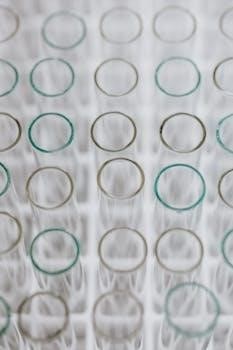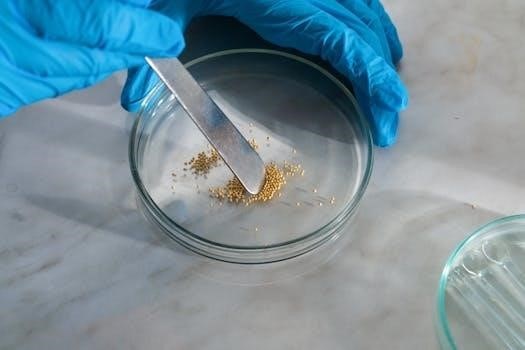Lab Manual for Chemistry⁚ An Overview
A chemistry lab manual serves as a vital guide for students, outlining experiments, procedures, and safety protocols. It’s designed to complement lectures, fostering hands-on learning experiences. These manuals often include pre-lab assignments and post-lab reports. They are available from various sources, including college bookstores and online.
Chemistry lab manuals are essential tools for students engaged in practical chemistry education. These manuals serve as a roadmap, guiding learners through experiments, procedures, and safety regulations. They are designed to translate theoretical concepts into tangible experiences, enhancing understanding and retention. A well-structured lab manual is more than just a list of instructions; it’s a comprehensive resource that supports the scientific method, promoting critical thinking and analytical skills. The manuals often include pre-lab exercises to ensure students are prepared for the experiment, and post-lab questions to reinforce what was learned. They provide a standardized approach to laboratory work, ensuring consistency and accuracy. Many lab manuals are tailored to specific courses or textbooks, aligning experiments with the curriculum. Furthermore, they often incorporate safety guidelines to prevent accidents and promote responsible laboratory practices. Students should view the lab manual as an indispensable companion, not just a set of instructions. The use of lab manuals is integral to the learning process, bridging the gap between theory and practice in chemistry education. The manual is key to a student’s success in the lab.
Ordering and Availability of Chemistry Lab Manuals

Chemistry lab manuals can be obtained through various channels, ensuring accessibility for students. Many college bookstores stock these manuals, often bundled with textbooks for specific courses. These bookstores offer a convenient option for students who prefer physical copies. Online retailers also provide a wide selection of lab manuals, catering to diverse needs and budgets. Some publishers offer direct sales, allowing students to purchase manuals straight from the source. Digital versions, such as PDFs, are increasingly common, offering convenience and portability. These digital manuals can often be accessed on multiple devices, eliminating the need for physical storage. However, some manuals, like student editions, might not be available in PDF format, requiring a purchase of a physical copy. Ordering details can usually be found on university websites or course syllabi. Before purchasing, it is essential to verify the correct edition and compatibility with the course requirements. Students should also be aware of any specific ordering deadlines or procedures. The availability of manuals may vary based on the academic institution and course.
Content and Structure of a Chemistry Lab Manual
A typical chemistry lab manual is meticulously structured to guide students through experiments effectively. Generally, it begins with an introduction explaining the purpose and objectives of the manual and the course. This is followed by a section on safety regulations and guidelines, which is crucial for ensuring a safe laboratory environment. The core of the manual comprises detailed experimental procedures, often following a logical sequence that aligns with the lecture curriculum. Each experiment typically includes a pre-lab section, requiring students to prepare before coming to the lab. This often involves a review of theoretical concepts, chemical properties, and potential hazards. Following the pre-lab, the manual outlines step-by-step procedures, specifying the apparatus, materials, and chemicals required. It may also include diagrams or illustrations to clarify complex processes. Post-lab sections usually contain questions or data analysis tasks, prompting students to interpret their results and formulate conclusions. Additionally, many manuals incorporate appendices with relevant information, such as tables of physical constants, chemical formulas, or glossary of terms. The overall structure ensures a systematic approach to learning and understanding chemistry concepts.
Safety Regulations and Guidelines in Chemistry Labs
Safety in a chemistry laboratory is paramount, and lab manuals emphasize this with detailed regulations and guidelines. These guidelines typically begin with general rules, such as no eating or drinking in the lab, and the necessity of wearing appropriate personal protective equipment (PPE). This includes safety goggles to protect eyes from chemical splashes and proper footwear to prevent injury from spills. Lab manuals often stipulate that long hair must be tied back and loose clothing should be avoided to prevent accidents with flames or chemicals. Students are instructed to familiarize themselves with the location of safety equipment, including fire extinguishers, eyewash stations, and first aid kits. Furthermore, manuals stress the importance of being aware of the potential hazards associated with each chemical used. Proper chemical handling, storage, and disposal procedures are also included, highlighting the need to avoid open containers of organic solvents. Students are generally required to be prepared for the experiment before entering the lab, ensuring they understand the method of operation and potential risks. Failure to adhere to these safety regulations can lead to serious injury and may result in removal from the laboratory.
Pre-Laboratory Preparation and Procedures
Effective pre-laboratory preparation is essential for a successful and safe chemistry lab experience. Lab manuals emphasize the importance of thoroughly reading and understanding the experimental procedure before entering the lab. This preparation typically involves completing a pre-lab assignment, which may include calculations, answering questions about the experiment, and outlining the procedure in your own words. Students are often required to identify the chemicals they will be using, understand their properties, and be aware of potential hazards. The pre-lab preparation ensures that students come to the lab prepared to actively participate and understand the purpose of the experiment. Many manuals include a pre-lab quiz which must be passed before being allowed to start the experiment. This is to ensure the student understands what is going to happen and what safety concerns are present. In addition, proper pre-lab preparation allows students to use laboratory time efficiently, focusing on the experiment rather than figuring out the steps; This preparation also significantly reduces the chances of accidents and errors during the experiment, leading to more reliable and meaningful results.
Experiment Design and Methodology in Chemistry Labs
The design and methodology of experiments in chemistry labs are crucial for obtaining accurate and reliable results. A well-designed experiment typically starts with a clear objective or research question, followed by a detailed plan that outlines the materials, equipment, and procedures to be used. The methodology section of a lab manual provides students with a step-by-step guide on how to conduct the experiment, often including diagrams or illustrations of apparatus setup. It emphasizes the importance of controlling variables to isolate the effect of a single factor on the outcome. Proper experimental methodology also includes the use of appropriate techniques for data collection, such as titrations, spectrophotometry, or gravimetric analysis. It also includes a requirement to record all data and observations accurately in a lab notebook. Furthermore, the manual often includes guidance on how to analyze the data, interpret the results, and draw meaningful conclusions. Experiment design also includes safety precautions to ensure the safety of the student. The overall aim is to teach students the scientific method.

Proper Use of Laboratory Equipment and Instruments
The correct use of laboratory equipment and instruments is paramount for obtaining precise and dependable results in chemistry experiments. Lab manuals provide detailed instructions on the operation of various tools, such as balances, burettes, pipettes, spectrophotometers, and pH meters. This section of the manual also emphasizes the importance of calibrating instruments before use to minimize errors. Students are instructed on how to handle glassware properly, avoiding cracks and breakages, and how to clean equipment after use. The manual often includes diagrams or illustrations showcasing the correct way to assemble and use specific instruments. It highlights the need to handle electrical equipment safely, avoiding electrical shock, and emphasizes the need to be aware of potential hazards associated with each piece of equipment. Proper technique includes understanding the limitations and capabilities of each instrument. The manual also provides guidance on troubleshooting common issues. Therefore, this section ensures students gain the skills needed for accurate and safe experimentation. Furthermore, they are taught to report any malfunctions immediately.
Chemical Handling, Storage, and Disposal

The safe handling, storage, and disposal of chemicals are critical aspects of any chemistry laboratory. This section of a lab manual provides detailed guidelines on how to manage chemicals to minimize risks. It emphasizes that all chemicals should be treated as potentially hazardous. Specific instructions are provided regarding personal protective equipment (PPE), such as gloves and goggles, which should be worn when handling chemicals. The manual includes information on proper techniques for transferring chemicals, such as avoiding splashes and spills. It also covers the different storage requirements for various types of chemicals, considering factors like flammability, reactivity, and toxicity. The manual also includes information on how to label chemical containers and how to keep a clean and organized workspace. Students are instructed on how to properly dispose of chemical waste, following established protocols. This section also highlights the importance of never pouring chemicals down the drain without specific instructions. The manual outlines procedures for handling spills and accidental exposure. These protocols are designed to protect the environment and the well-being of everyone in the lab.
Laboratory Notebook Maintenance and Reporting
Maintaining a detailed and accurate laboratory notebook is essential in chemistry. This section of the lab manual provides guidelines on proper record-keeping practices. It emphasizes that the lab notebook is a primary source of data and should be written in ink. The manual outlines the necessary components of a well-maintained notebook, including experiment titles, dates, objectives, procedures, observations, and calculations. It highlights the importance of recording data directly into the notebook during the experiment, not afterward. The manual should include examples of how to properly format tables and graphs. It also provides guidance on how to handle errors or corrections. Students are instructed to clearly and concisely write their reports, using proper scientific language. The importance of including all raw data, including any notes about unusual events during the experiment, is emphasized. The manual should also include information on how to write a proper conclusion, summarizing the findings and their significance. Furthermore, the manual will provide guidelines on proper citation and referencing. The lab manual should also outline the format for post-lab reports.

Specific Experiments and Techniques in Chemistry
This section of the chemistry lab manual delves into specific experiments and techniques commonly used in chemistry laboratories. It provides detailed instructions for various procedures, such as titration, distillation, and chromatography. The manual includes step-by-step guides for each experiment, outlining the necessary equipment, chemicals, and safety precautions. It covers both qualitative and quantitative analysis techniques, such as gravimetric analysis and spectrophotometry. The manual also includes explanations of the underlying chemical principles behind each experiment and technique. It should include procedures for synthesis, separation, and purification techniques. This section also provides information on how to prepare solutions of varying concentrations, and how to perform dilutions. Furthermore, the manual covers the handling and use of specialized equipment, including spectrophotometers, pH meters, and burettes. Students will learn how to collect and analyze data accurately. This part of the manual also includes examples of typical results that can be expected from each experiment. The manual may also include advanced techniques, like nuclear magnetic resonance, if appropriate for the course. It emphasizes the importance of following procedures precisely to ensure accurate and reliable results. This section promotes the development of both practical and analytical skills.